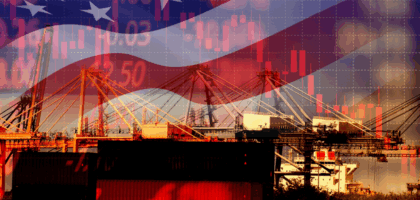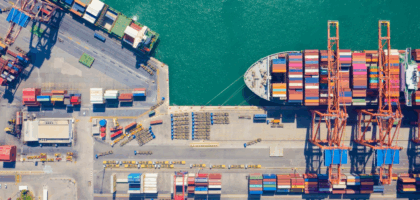It’s the most wonderful time of the year…or is it?
Many people may not think so once they experience the rippling effects of the global shipping crisis during their annual holiday shopping. There will be many surprises this year—and not those good ones that come in wrapped packages. Higher prices, product shortages, and empty shelves will be the new norm this holiday season, whether we like it or not.
What is the cause of all this?
If we could boil this down into one phrase, it would be: demand far outweighs supply. What does that mean exactly? There are several contributing factors to the global supply chain chaos.
Ports Everywhere Just Can’t Keep Up
Although pretty much every mode of shipping has been impacted, ports have faced the most difficult challenges during the pandemic. Some of the world’s largest ports, especially on the U.S. West Coast and China, are dealing with a congestion crisis, with hundreds of containerships waiting to unload. This issue didn’t occur overnight either. This huge supply chain disruption has been snowballing for months and is showing no signs of slowing down anytime soon. In fact, the backlog at ports is likely to stretch into the first half of 2022.
Lack of Workers and Shipping Containers
Thanks to COVID-19 and the unexpected Delta variant, the world of work has changed in drastic ways. In April of this year, four million people quit their jobs with the largest exits happening in retail trade, warehousing and utilities, and—you guessed it—transportation. The unimaginable shortage in the workforce of these industries has made a huge negative impact on the global supply chain, making it almost impossible to keep up with daily operations.
And that’s not even the half of it. A lack of shipping containers has also contributed to this logistical mess. That’s due to all the containerships sitting off the coasts waiting to get into the ports to unload. To put it in perspective, a large, modern cargo ship can carry over 21,000 TEUs (Twenty-Foot Equivalent Units), and with hundreds of them waiting like sitting ducks, you can understand just how many containers are currently being utilized.
Astronomical Shipping Costs
Due to intense demand, container shipping rates have skyrocketed. The cost of sending a container from Asia to Europe is about 10 times higher than in May 2020, while containers moving from Shanghai to Los Angeles has increased more than sixfold, according to the Drewry World Container Index. Spot prices per container on the China-U.S. East coast route (one of the world’s busiest container lanes) has also climbed over 600% from just one year ago.
Due to these rising costs, some shippers have reduced their volumes in less profitable routes, and some large retailers, including Home Depot, Target, Walmart, and Costco, have secured and chartered their own ships to reduce, not only costs, but the chances of their products and inventory not arriving on time for the busy holiday season.
Speaking of rising shipping costs and congestion, what does that mean for the holiday season?
Have you been to the store recently and noticed higher product prices or empty shelves? You’re not going crazy—that is likely how it will be for the holiday season and the foreseeable future. The lack of items in stores and raised prices is a direct result of a supply chain that has been stretched way beyond capacity. And although a lot of consumer shopping habits have shifted to online, you can expect delays there, too, as it’s impossible for the supply chains to keep up with this demand.
How can I get ahead of my holiday shopping (and shipping) concerns?
- Start shopping early.
Although many consumers wait for Black Friday to begin their holiday shopping (who doesn’t love a sweet deal?!), this is not the year to do that. Write out your list and start shopping now. If you put off shopping until closer to the holiday, your gifts may not arrive on time, or products you had your eye on may be out of stock for the foreseeable future. - Have realistic expectations.
Everyone wants the latest and greatest thing—it’s human nature. That being said, many manufacturers, including Google and Apple, have already started whittling down their inventory to make sure they can keep items in stock. With certain products, such as phones, laptops, and other electronics, try not to focus on a specific style or color. Flagship items, like sweater, shirts, and jeans, will be much easier to come by and you can be choosier with these types of products. - Consider the retailer.
As mentioned earlier, larger retailers, such as Walmart, Home Depot, and even Amazon, have an upper hand on circumventing port congestion by chartering their own ships, switching from ocean freight to air freight, and even buying their own planes. If you’re set on finding and purchasing a specific item (in a specific color or style), stick with buying from a large retailer to increase your chances of getting it on time—or at all. - Keep your shopping domestic and local.
If you want to avoid the chances of ordering products online that may (or may not) get here on time for the holidays, you can always personally handpick gifts for your loved ones yourself. This is a great year to visit and shop small and local businesses. And it’s always great to support these smaller companies!
As a business, is there a way to make your supply chain more resilient?
While businesses can’t control their processes on a global scale, it is still possible to keep your supply chain resilient. How can you do that?
- Gather more data from your suppliers and look at all points in your supply chain where bottlenecks could occur. Mark these down and come up with solutions and plans to alleviate and work around these potential bottlenecks.
- Work on your inbound transportation strategy to ensure it remains flexible when delays are known or anticipated.
- Partner with a logistics company who can help give you insight and transport your goods effectively and efficiently. By partnering with a reputable freight forwarder, shipping strains and unknown compliance regulations can be navigated by professional and seasoned experts, helping you avoid any setbacks or errors.
Resources:
- How Does the Global Port Congestion Impact Your Supply Chain? (Agistix)
- The World Economy’s Supply Chain Problem Keeps Getting Worse (Bloomberg)
- China-U.S. Container Shipping Rates Sail Past $20,000 to a Record (CNBC)
- Why the Supply Chain Crisis Could Screw Up Your Holiday Shopping (Boston University)
- Tips to Start Your Holiday Shopping Early (WIRED)



